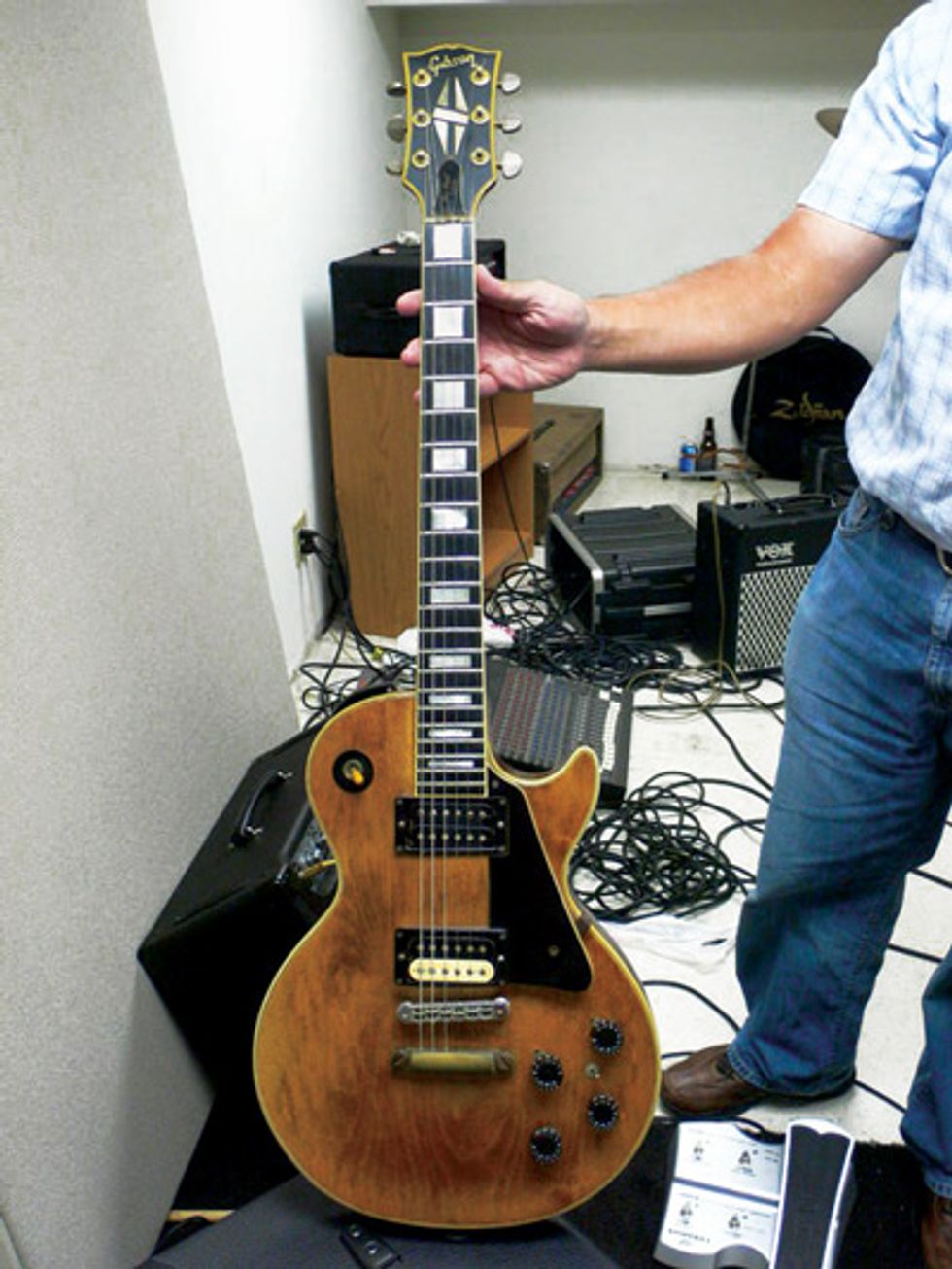Does restoring a vintage instrument really make it better?
I once interviewed Mark Karan, guitarist
extraordinaire for Ratdog and Jemimah
Puddleduck, and L.A. session guru and total
gearhound. Mark had a refreshing take on
gear. He told me, "Because I want to actually
use these instruments, I buy pieces that have
what collectors might call ‘issues,’ like non-
original hardware or having been refinished.
To me, it’s the old wood that matters, and as
long as the wood is there, I can find a way
around the issues. When I bought my ’51
Nocaster, I strummed it unplugged and knew
I couldn’t walk out of the store without that
guitar. And that’s one a collector wouldn’t be
caught dead with, simply because somebody
had slapped another type of paint on it."

David Loo’s 1969 Les Paul Custom. Photo by Wallace Marx
You can see the wisdom. Get past the looks and listen to the tone. Avoid letting a few mods and perhaps ill-advised "upgrades" sway you, and ask yourself, "Do I like this guitar? And what does it matter what the snobs say?" Mark got what would turn out to be his number-one touring guitar. If you remember Stevie Ray Vaughan’s yellow Strat, you might not know that axe had a swimming-pool route in it from having four humbuckers installed. I once had a Ventures model Mosrite I loved, despite the fact that it had a Floyd Rose and a god-awful leopard paint job.
Sometimes, great guitars get hacked up and still sound great. But in these days of vintage-correct-or-die sensibilities, we get roped into a knee-jerk, lock-step march toward restoring—or even over-restoring—all in the name of authenticity. And, friends, authenticity does not always equal bitchin’ tone.
It happened to me recently. I work with a great guy named David Loo. He’s a world-class programmer, a total genius type. One of those guys who can look at a page full of code, the kind of stuff that would make most people go blind, and spot the error among thousands of strings of digits. David is also a blues lover. I’m always accessing his iTunes library over the company network to hear all the Albert King songs I don’t have. David can play a lot of these tunes and play them quite well. He is also a serious gearhound—enough so that he makes a line of effects pedals that are unique and off the charts, tonewise. The man knows what he’s talking about.
We have a guitar room downstairs at work. Last week, David asked me if I wanted to see his Les Paul. Love to, I said. We went down to the room and he pulled out a beat-up case that was obviously for a Les Paul. My pulse went from semi-interested to gotta-see-it-now in a nanosecond. The guitar he pulled out was indeed a Lester, a 1969, David told me, and I could see it was a Custom.
Or, the vintage-snob in me said, it once was a Custom. The axe had survived a classic ’70s mod job: finish stripped on top, back, and sides. Unpotted humbuckers with well-warped plastic surrounds. Non-stock Grovers. And the biggest ’70s giveaway, a mini-toggle switch laid between the volume knobs.
Working through my disappointment, I began telling David what he could do to restore it. Re-fin. New hardware. Fret job. And plug that dang mini-toggle.
But then I strapped it on and started playing. And the more I did, the more I started to feel like I was holding a really good guitar. Nice weight, maybe nine pounds. Without the finish the body felt wonderful and the neck smooth.
The action on the ebony board was el perfecto and the neck straight with a perfect amount of relief. Unplugged that LP sang with sweet Spinal Tap-like sustain. I couldn’t put it down.
I asked him how much he wanted for it—an instant attack of G.A.S! Not for sale, David said with a knowing smile. He has owned this guitar for 20 years after buying it out of the paper (remember that?) and in all this time, it has never had so much as a simple set up. I loved it, and since he wouldn’t sell it to me, I told him to never get rid of it—which was obviously his intention anyway.
So here’s the big point: When you see a guitar that’s had some surgery, give it a chance before you turn up your nose. Ask yourself if you like this guitar. Ask yourself if it plays and sounds like what you want. Determine your opinion before you listen to the chat-room rabble that will always try to talk you into dumping serious cash for questionable gain. If the answer is yes, I like it, move to the next step. Why should I change it? Why should I immediately restore it? Will I like it more? Will it be better? Maybe it will be better to the money people, the guys who appraise and trade and buy and sell. But how it plays for you is what matters. David loves his modded and beat-up Custom and I can see why.
Remember that scene in Spinal Tap (wow, two references in one column) where David and Nigel are discussing the death of one of their drummers? "Authorities said...best leave it...unsolved," one remarks. Maybe that holds true for some guitars as well. Perhaps sometimes we should resist the urge to re-vintage an axe and just leave it alone.
Wallace Marx Jr.
Wallace Marx Jr. is the author of Gibson Amplifiers, 1933– 2008: 75 Years of the Gold Tone. He is a lifelong musician and has worked in all corners of the music industry. He is currently working on a history of the Valco Company. He is a children’s tour guide at the Museum of Making Music, a struggling surfer, and he once hung out with Joe Strummer.

